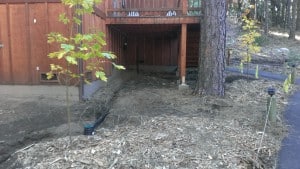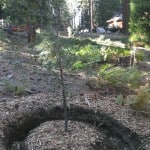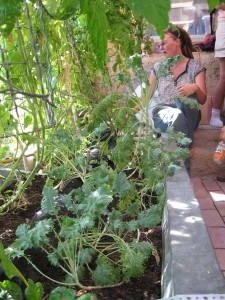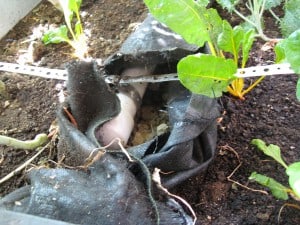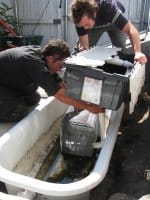Greywater Systems in Freezing Climates
Year-round greywater reuse in cold climates can be a challenge. What to do with all that water when the garden’s under snow? Will greywater freeze in the pipes? Many greywater users divert greywater to a sewer or septic system during the cold season, but it’s possible to reuse greywater even in the dead of winter.
Maintaining your system in freezing weather requires additional planning and precautions to prevent system failures:
- Pipes must drain completely of greywater. Any standing water in pipes could freeze and block the pipe, or potentially burst it. Gravity based systems must be carefully installed so all pipes slope downwards to avoid standing water. Make sure all water can drain out of the lines of any pumped systems (either drain it back to the tank or out into the landscape).
- If you can’t drain the lines in a pumped system create an automatic bypass tube at the beginning of the system. If there is freezing in the main line water can safely escape out the bypass, for example a tee with a tube running high up (high enough so greywater only flows out in case of a blockage).
- Another options is a greenhouse irrigated by greywater to produce food and greenery all year long.
- If you decide to shut off the system during the winter make sure to drain down any places containing standing water. You can install a drain-down valve at low points in the system (use a tee with a ball valve, keep the valve closed to use the system and open it to drain the line.)
Examples of Cold Climate Greywater Systems
 Gravity, Branched Drain Systems (at Evergreen Lodge)
Gravity, Branched Drain Systems (at Evergreen Lodge)
Location: Yosemite, CA
Evergreen Lodge, located in the Sierra Nevada Mountains, recycles nearly a million gallons of greywater each year from 55 guest cabins, staff housing, and the commercial laundry facility. The 55 systems from the guest cabins are all simple, gravity fed branched drain systems and have operated problem-free for the past four years. All systems, both gravity-fed and pumped, were carefully designed and installed so no water was left standing in the pipes. The system designer and installer, Sierra Watershed Progressive, monitors and maintains the systems.
A diverter valve (not shown) redirects shower water from under the cabin to flow outside. The greywater pipe is painted brown and labeled.
This system is under construction. The flow of shower water is divided multiple times with a “flow splitter.” Each outlet ends in a large basin.
Since the cabins are used by guests and the production of greywater fluctuates greatly (sometimes the cabins are empty, other times they are full), the basins were over-sized to provide surge capacity and enough area to infiltrate the potential large volumes of greywater. This basin will be filled width woodchips, they filter and absorb greywater, allowing it to slowly soak into the ground.
Greywater System in Greenhouse
Location: Cerrillos, NM
Diverting greywater to an attached greenhouse reduces the risk of frozen pipes, creates a heat sink (warm greywater) to heat the house all winter long, and provides water to winter gardens. Indoor and greenhouse systems should be well drained and ventilated to avoid mold-promoting damp conditions.
Ampersand Sustainable Learning Center has no sewer connection or septic system. All greywater enters the greenhouse, and can be diverted to an outside vegetable bed. The water flows out a perforated 1″ PVC pipe onto a pumice wick. The pumice releases water slowly into the surrounding soil. Excess water drains into the ground under the bed. Filter fabric covers the perforated pipe to allow easy maintenance while reducing human-greywater contact.
Greywater System for Monitoring: Irrigation or Wetland

When you live over the aquifer that supplies your city’s drinking water, returning greywater to the water table creates an intimate link with the water system. This demonstration system at MUD in Missoula, MT models year-round reuse of bathroom greywater in a cold climate. Its most visible component is a large, gravel-filled stock trough beside the back steps– filled with cattails and other beautiful wetland plants!
- Goals: 1. To reuse greywater from a bathtub for fruit tree irrigation during the summer and aquifer recharge during the winter. 2. To demonstrate effective greywater treatment and disposal strategies for floodplains and high-groundwater areas. 3. To study coliform, nitrogen, and phosphate removal in constructed wetlands–the system contains sampling ports before and after the wetland.
- Site description: This single-family house has a bathroom at the rear (south side) of the house, and little fall between the drain and grade. A vented 30-gallon barrel under the back steps functions as a surge tank. Greywater passes through a woodchip biofilter that traps grease and food particles, then enters a infiltrator inside a bathtub constructed wetland.
- Cost: 1 1/2″ 3-way valve $50, salvaged stock tank $0, salvaged pipe and fittings $25, filter fabric for frost-free sump $10, gravel $50. Total materials: $135.
- Fixtures: Shower/ bath.
MUD’s greywater system combines a number of elements to increase its flexibilty, cold-weather capability, and ease of water monitoring.
Sewer diversion valve: Directly after draining from the tub, the water encounters a 3-way valve; here, system users can choose whether to direct the water to the sewer, or outside. Diversion to sewer allows flexibility in case of a long freeze, or when using non-biocompatible body products (like hair dye or bleach).
Surge tank: Greywater destined for irrigation flows through a surge tank, a 30-gallon barrel located under the steps that regulates flow into the wetland. Greywater is not stored, but flows out the bottom of the tank.
Constructed gravel wetland: Water directed outside can enter the wetland, where it will be treated by gravel-colonizing microorganisms and by plants. Pathogens, dirt, and soap are taken out of the water, rendering it safe for release into a sump (winter) or for irrigation.
Direct greywater irrigation: In summer, almost all the water can be diverted to bypass the wetland (it just needs enough to keep the plants alive) and enter subsurface distribution pipes. The current plan allows for the watering of the apple tree and a small flower bed, but can easily be altered to meet future needs.
Inline sampling valves: Both inflow and outflow pipes are equipped with valves to allow the sampling of water before and after treatment by the wetland. This monitoring will provide important data toward the development of greywater treatment strategies in this climate.
MUD’s system is designed to comply with the greywater best practices incorporated into Arizona and New Mexico’s greywater codes–the codes that Montana’s soon-to-be-implemented greywater law is modeled on. These best practices include the option to divert greywater to the sewer, and subsurface infiltration into the top 9″ of soil, the “root zone” where most microorganisms that break down greywater reside. The system incorporates cold-climate strategies developed by John Todd in Vermont.
Ecological Disposal and Irrigation Wetland
Location: Providence, RI
- Goals: To divert all sink water from the sewer, model ecological wastewater treatment, and irrigate wetland and upland medicinal plants. Resident plans to reuse bathroom greywater after bathroom remodel (pipes are inaccessible).
- Site description: This single-family house has two bathrooms and a kitchen sink. Greywater passes through a woodchip biofilter that traps grease and food particles, then enters a infiltrator inside a bathtub constructed wetland.
- Cost: 1 1/2″ 3-way valve $50, salvaged bathtub and pipe $25, fittings $15, plastic biofilter container $10 Total materials: $100. Concrete saw rental: $55.
- Fixtures: Because residents grow and process large quantities of food and medicinal plants, the sink produces an estimated 25 gal/day of greywater. A 3-way valve diverts greywater to either the sewer or wetland.
This system uses sink water to irrigate wetland plants and demonstrate biological wastewater treatment. Treated effluent irrigates medicinal herbs, but little water exits the wetland during the summer. Because the wetland is buried and located against the south side of the house, the wetland has yet to freeze after 2 winters of use.
An insulated woodchip biofilter removes grease and food particles. The biofilter’s drain sleeves into a mesh-covered infiltrator for easy removal and maintenance.

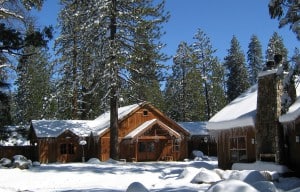
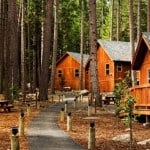 Gravity, Branched Drain Systems (at Evergreen Lodge)
Gravity, Branched Drain Systems (at Evergreen Lodge)
